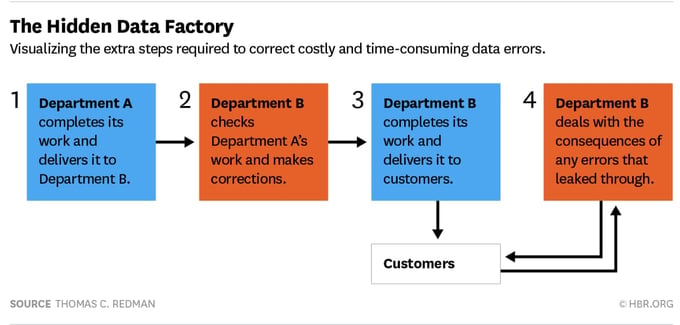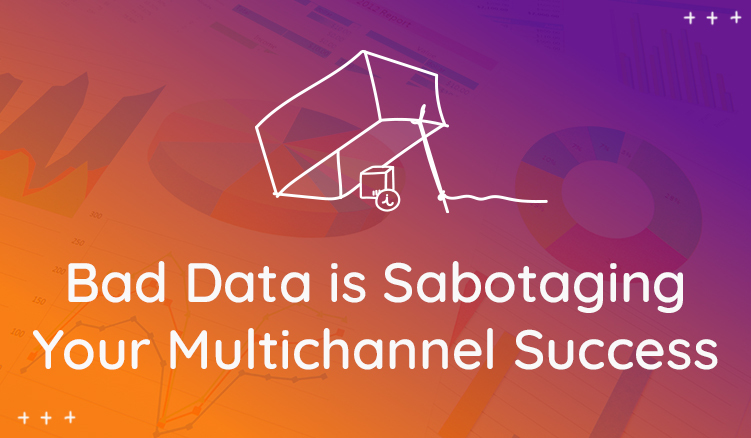Most small businesses underestimate how poor data can affect bottom lines.
In fact, Gartner estimates that organizations lose an average of $15 million per year because of bad data. And, this number is likely to rise as the retail environment becomes more digitized. “Not only are organizations taking a financial hit, but poor data quality practices also undermine digital initiatives, weaken their competitive standing and sow customer distrust,” says Mei Yang.
In addition to that, retailers are still facing the challenge of siloed data.
What is siloed data?
Siloed data is information that is only accessible to a specific department.
In the past, information used to be stored in file cabinets where multiple people could easily access and view data, but now that data has gone digital, it has almost become harder to locate. This causes a disconnect between departments or teams, a lack of transparency and efficiency, and well...poor data management.
How siloed data impacts your business
The statistics show that in-store and ecommerce retail is a lucrative market, with global retail businesses recording $22.5 trillion in 2020 and is projected to reach $26.7 trillion by 2022. Suppose your company still operates under siloed product content management. In that case, you’re compromising your opportunity to earn a spot in the list of stores that will gain growth in sales in the coming year.
Siloed data affects teamwork, which, in turn, affects the customer experience.
Let’s explore how this works.
The risks of siloed data for your internal teams
The challenges of poor data begin internally and are often dismissed due to being “small mistakes.” But small mistakes have big consequences in the long run.
The most common reasons for siloed data include;
- Company hierarchical structure - where departments don’t understand or ignore how other departments can benefit from the same data
- Technology issues - when companies do not have the right technology to ensure information can be easily passed between departments
Besides the fact that data may not be readily available to teams who need it, there’s plenty of room for information to be 1.) duplicated, 2.) missing in required fields, and 3.) live in multiple locations. This can lead to conflicting information.
Now, you’re probably wondering what conflicting information looks like?
In retail, it includes, but is not limited to:
- A product or SKU that is placed more than once in a list
- Out-of-stock items that still reflect as in-stock
- Content placed in the wrong field. For example, 'price' where 'size' should be
- Information that doesn’t match the attribute type specifications
- An empty field where there is product information necessary
Imagine this, your marketing department is trying to put together a sales enablement tool, say a product catalog for resellers, and they pull up a spreadsheet with outdated information. That information is different from the content used on the brand’s site. Now the marketing team has to spend time tracking down the “final” spreadsheet. That’s a time-consuming task that could be avoided if all teams had a central source of truth to use collaboratively.
Research suggests that workers spend 50% of their time hunting and correcting errors and searching for sources to confirm data they don’t trust.

That’s not a productive way for your teams to perform their tasks, nor is it an efficient way for your business to run.
The risks of siloed data for your customers
As you know, customer experience is the heartbeat of retail.
Whether online or offline, customers expect a frictionless experience when interacting with a brand. If they experience poor data information, they will lose interest in buying the product or will be unhappy with the product they receive.
This is evident in product returns and shopping cart abandonment issues that keep retail shop owners up at night. According to the National Retail Federation, total returns account for over $400 billion in lost sales for United States retailers alone. Moreover, online returns have more than doubled and are a major driver of the overall growth of returns. Meanwhile, for ecommerce stores specifically, the average cart abandonment rate is 69.80%, according to this study.
The next loss you’ll experience is brand reputation and loyalty, which means you’ll have challenges retaining customers and finding customers who will be advocates for your business. Unless you start working on improving your data quality and, ultimately, customer experience, you’re going to continue to lose money.
Research shows that improving customer experience earns businesses a total of 80% in revenue increase. According to Melody Chien, a senior director analyst at Gartner, “good quality data provides better leads, a better understanding of customers, and better customer relationships.” That means you’ll need to invest in a product content management system that gets the job done and ensures you no longer have to lose millions of dollars due to bad product data.
Improve your product quality and workflows with PIM
Gartner predicts that by 2022, 70% of organizations will rigorously track data quality levels by metrics, improving it by 60% to reduce operational risks and costs significantly. What if we tell you that you can expedite this brilliant move with a Product Information Management (PIM) solution? A PIM eliminates the risks of siloed data by seamlessly centralizing product content. Not only that, but every employee across departments will have instant access to the same tool housing the same error-free, up-to-date, and rich product data without any hassles.
That’s right, Plytix PIM, for instance, has the capability to help you maintain data in a consistent and collaborative manner, so no one can waste valuable time searching for Excel spreadsheets or Dropbox folders to cross-check and correct product information. The tool holds your hand throughout the data management process so that you can focus your attention on growing your business.
Keen to learn how this tool can help you break down siloed data and save money instead of losing it? Book a demo with us to see the tool in action!





